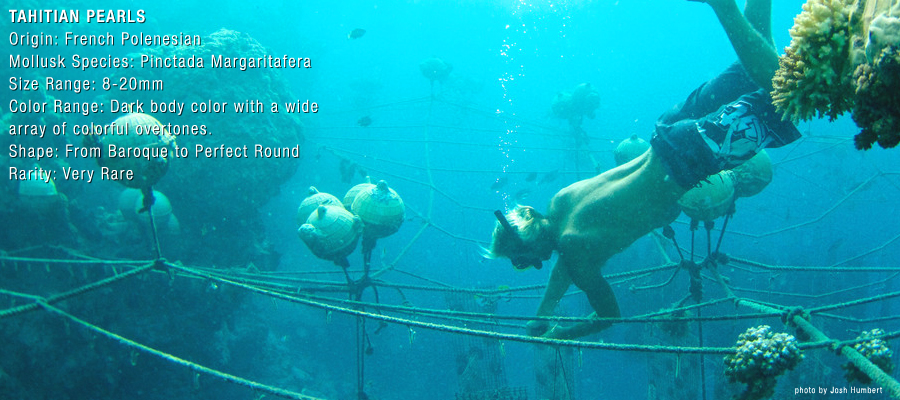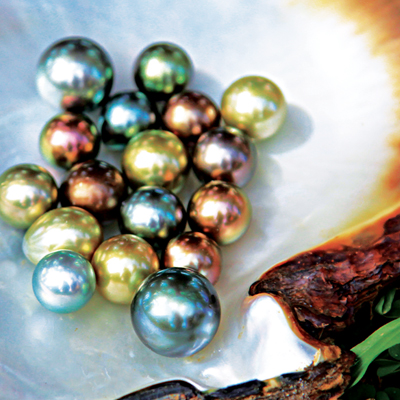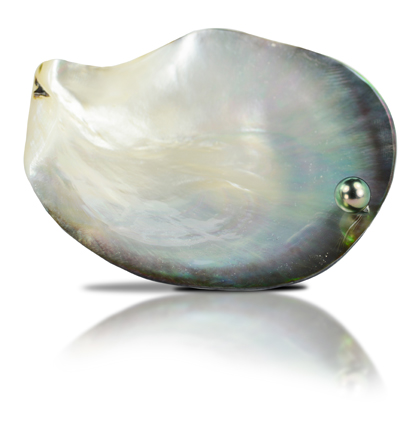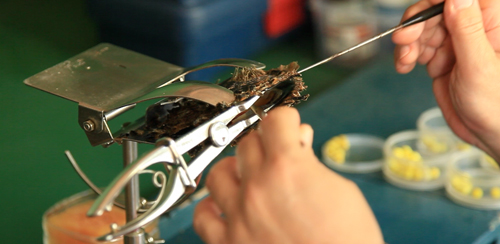
THEIR ORIGIN Referred to as "Black Pearls" or Tahitian Pearls, these beautiful gems are prized for their colors and exotic appeal. Although they are referred to as Tahitian pearls no pearls are actually grown there. Tahiti is merely the trading center in which black peals from the surrounding islands (French Polynesia) are exported. Tahiti is one island in an archipelago consisting of many smaller islands and Atolls. It is within these Islands and Atolls that you will find pearls being cultured and farmed. The "black lipped oyster" is not just farmed in Tahiti but in the Cook Islands and Fiji as well. It is because of the nature of the large and superb shells that thrive in Tahiti that they are able to produce their pearls so effectively. HISTORY The first man ever to experiment with pearl farming in this area of the world was Jean-Marie Domard. Domard a Frenchmen was responsible for the marine resource division and began his pursuit of the black pearl in the early 1960's. Following in the tradition of the Mikimoto, he began experimenting with the Pinctada margaritifera using Japanese culturing techniques. In 1961 he arranged through the french government to bring in professional Japanese pearl technicians into Tahiti. After a few years of failed attempts, in 1965 Domard successfully harvested approximately 1000 high quality Tahitian pearls. This harvest was the result of nucleating 5000 oysters and waiting for 3 years. Not only did this motivate the Tahitian government but the private sector as well. The first farm was established in Hikueru and the second in Bora Bora. |
 |
| The first recorded export of Tahitian pearls was in 1972, a modest 1,563 grams with a total value of US $3,363. From that point on the growth was exponential by 1995 the total export amounted to a staggering 5,000 kg with a total value of $152 million US. At this point Japan was purchasing 70% of the pearls produced and the U.S. only 10% but this would soon change. The mid-1970's marked a pivotal turning point in Tahiti’s pearl industry as a man named Jean Claude Brouillet entered the picture. Brouillet a colorful and adventurous character would purchase a large Atoll known as Marutea Sud in the South Eastern Tuamotus. Marutea Sud would prove to be a pearling goldmine with it's extremely large oysters and ideal combination of factors proving to be absolutely ideal location. At this same time another ambitious pearl maven by the name of Robert Wan would be beginning an operation of his own on the island of Mangareva. Through good business practice and aggressive marketing Robert Wan would grow his operation to a level never imagined. Wan would eventually purchase Marutea Sud in 1984 and by 1997 his company was producing 60% of the worlds Tahitian Pearls. Today Mr. Wan remains at the top of the Pearling industry in Tahiti. Besides Wan there are a few other major producers followed by about 20 medium sized operations and a few hundred small farms. |
|
MOLLUSK SPECIES The oyster that is responsible for the creation of these magnificent gems is known as the Pinctada Margaritafera. This oyster is indigenous to Tahiti and the surrounding islands. The Pinctada Margiritafera is also referred to as the black lipped oyster because the edges of the inner valves tend to be very dark or even black as depicted in the image to the right. Although this oyster is smaller than the Pinctada Maxima or South Sea oyster it still grows quite large thus producing large pearls. The average size of these oysters is around 12-15cm in diameter sometimes-exceeding 20cm the pearls that are produced range in size from 8-18mm and even larger in rare cases. In the family of Pinctada Margaritafera there are many sub-species. The largest of the sub-species is known as the (Cumingi). This shell thrives in the waters of Tahiti. The Cumingi tends to have a very dark lip; shells farmed in the Cook Islands tend to have a more brownish lip. In Fiji there is a sub species being farmed that tends to have a very colorful lip producing stunning pearls in a plethora of exotic colors and overtones. |
 |
METHOD OF COLLECTION Where as many pearl producing regions actually grow their stocks of oysters in hatcheries Tahitian pearl oysters are obtained by a method called "spat collection". These oysters undergo external reproduction, so when triggered often by change in water temperature the males release their semen and the females release their eggs. The farmers station long pieces of fabric in the water around the oysters, which are known as spat collectors. The free-floating larvae attach themselves to these collectors. Once the larvae grow to oysters of about 2cm in diameter they are carefully collected and raised into maturity. |
|
GRAFTING Grafting is the process in which a mother of pearl nucleus is inserted into the gonad of the oyster. The nucleus acts as an irritant in which nacre is deposited around and a pearl is formed. This is a surgical procedure performed by a skilled technician. It is said that the quality of the pearl can be directly related to the skill of the technician. |
|
Harvesting: After about two years after the grafting operation is performed those oysters that have actually survived their time in the water are ready to be harvested. It is only about 5% of pearls that come out round and even fewer that possess all of the traits to categorize the pearl as gem quality. WHAT TO KEEP IN MIND WHEN BUYING TAHITIAN PEARLS Choose pearls as if choosing a rare gem. Don't just rely on common strands, but know that you can make a gorgeous piece of jewelry with one perfect pearl. When buying pearls, first take into account what shape you're looking for. Round doesn't necessarily mean better, as Drop, Oval, Baroque or Semi Baroque pearls can make for lovely hanging jewelry. Tahitian pearls take on a variety of colors, from aborigine to green to gray to black. Japanese tourists flock to the island to pick up Peacock pearls, green on the outside and pink toward the center. European markets typically favor bluer shades. It's all a matter of personal taste. It is key when choosing pearls to look for luster - how the pearl absorbs and reflects the light. A dull pearl is a dead pearl. Next, examine the pearl for dots and imperfections. While a flawless pearl is ideal, Grade B pearls, with a few marks throughout, are also considered a high-quality find. Consumers can find much larger pearls in the Grade C and D range, heavily marked or circled pearls, at lower prices if size is of importance. |
 |
 |
|